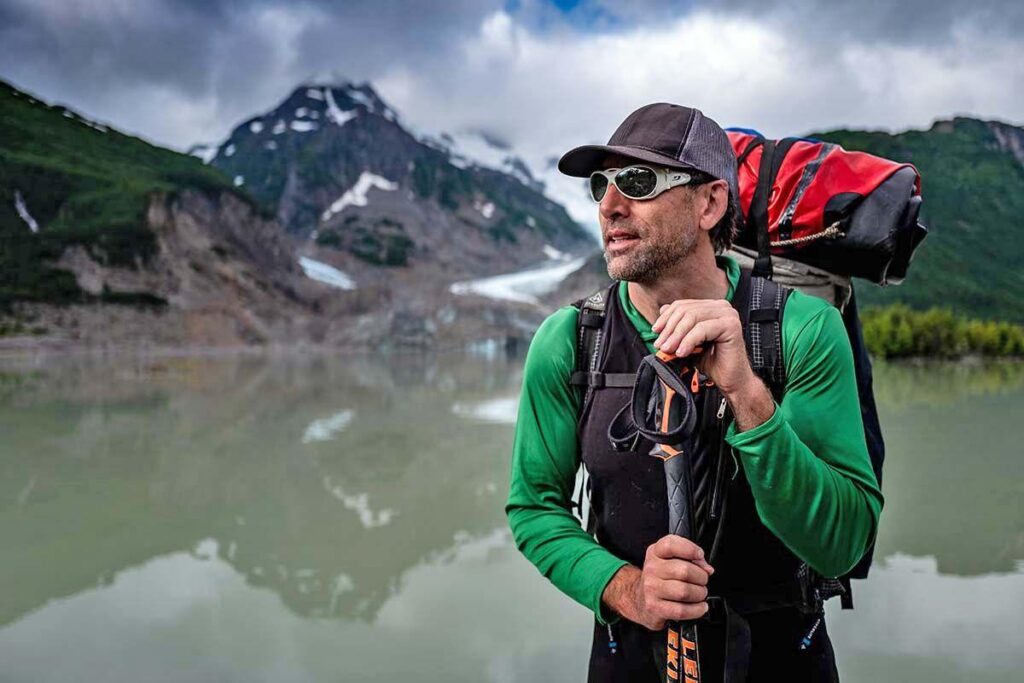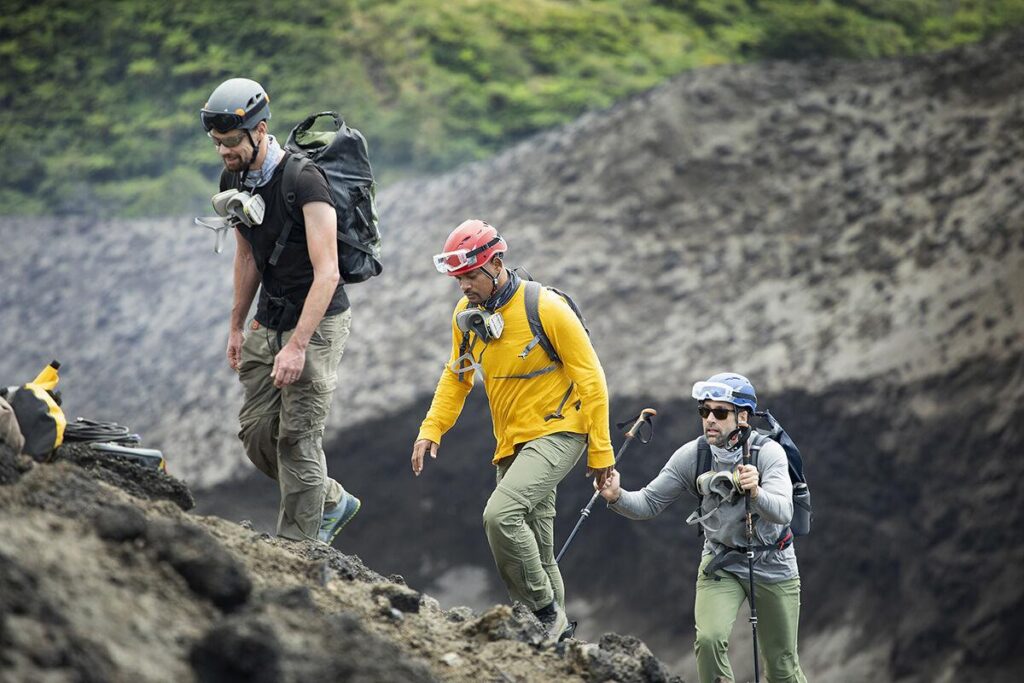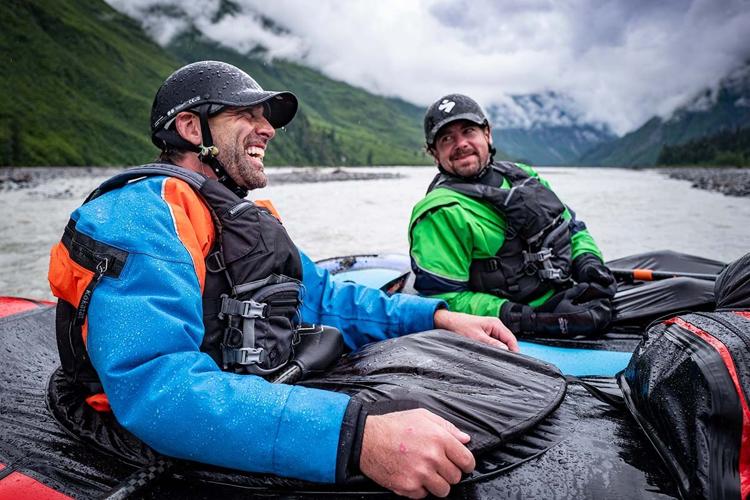Meet the blind explorer who takes Will Smith to the ends of the Earth in a new series
by Andrea Valluzzo | Connecticut Magazine, December 23, 2021

Climber Erik Weihenmayer went blind by age 14 from a condition called retinoschisis, but he never lost sight of how to live a life of adventure, turning challenges into opportunities. The first blind mountaineer to climb Mount Everest, he has undertaken many outdoor challenges, from kayaking the 277-mile stretch of the Colorado River that runs through the Grand Canyon to climbing all Seven Summits. The 53-year-old Connecticut native and Weston High School graduate recently undertook a new set of adventures alongside actor Will Smith for a Disney+ show from National Geographic, Welcome to Earth.
“I’ve got a confession to make,” Smith, who hosts and produces the show, says in the trailer. “I’ve never climbed a mountain, never swum in a lake. I was in a cave once. I’m beginning to think that I might be missing something. I asked the best modern-day explorers, ‘Take me to the ends of the Earth.’ And they said, ‘Oh, we can go further than that.’ ”
One of those explorers is Weihenmayer, who is featured in two episodes of the six-part series now streaming on Disney’s subscription platform. It’s a multi-sensory adventure series exploring the planet’s hidden gems with a focus on sound, smell, speed, color and pattern.
In the first episode, “The Silent Roar,” Weihenmayer and Smith travel to a remote Pacific island and rappel into an active volcano to place sound sensors inside. After a week of dodging magma bombs and listening to the majestic and terrifying sounds of the volcano, they headed to a glacier in Alaska for a three-day kayaking trip down a river to the ocean. The Alaska trip revolves around smells and is featured in the fourth episode, “The Power of Scent.”

While most of Weihenmayer’s past adventures have been climbing mountains, braving whitewater rapids and ice climbing, the Golden, Colorado, resident says it wasn’t a big stretch to go into the Mount Yasur volcano on the island of Tanna in Vanuatu. “Once you are comfortable in the outdoors and you learn to assess risk — it kind of covers most of the bases in nature. I felt pretty comfortable. I understood how to rappel and stay safe and monitor myself and my team,” he says. “We had a really good safety crew there that was watching the wind … when one of those magma bombs would shoot up in the air, they would blow toward you and obviously that would be dangerous. They’re making sure the wind is blowing the opposite way. The idea is to minimize risk through a really good team and we had that.”
In keeping with the episode name, “The Silent Roar,” much of the volcano’s sounds were beyond human hearing, hence the need for the high-tech sensors. Weihenmayer says that while they could hear some of the smaller noises the volcano made, they could not hear the big booms. But they could feel them. “Some sound waves are so gigantic the human ear cannot detect them, but you feel these massive pressure changes in the cavities of your body. It was really quite wild and almost disconcerting to be experiencing sound but a sound you can’t hear,” he says. Even the “smaller” sounds of the volcano were quite intense, from vents of steam hissing and magma bombs exploding into the air sounding like rifle shots to the splashes in the lava lake below them.
As they entered the volcano, Weihenmayer showed off a skill that he developed after losing his sight. Through a series of sharp clicks and beats — to Smith’s amazement — Weihenmayer approximates distance, a practice known as echolocation often associated with bats. Weihenmayer’s favorite moments involved him and Smith just sitting or standing at the rim of the volcano or its caldera and listening. “We’d have this beautiful 45 minutes where we are just sitting there and in front of us was a kind of eerie explosive sound of the volcano — lava lakes rolling and shifting and all that nuanced sounds of gas, steam and magma,” he says. “We just sat there and we’re like, ‘Whoa, did you hear that one?’ and ‘Check out that one.’ It’s almost indescribable how wild and up close we were to this insanely powerful force of nature.”

Weihenmayer and Smith also shared some lighter moments. At the end of the volcano trip they stopped at a nearby watering hole to sample a local, mildly hallucinogenic drink. When the effects start to kick in, Smith says that his tongue goes numb and lips tingle. “If you think that’s bad,” says Weihenmayer, who has two glass eyes, “my eyeballs have gone numb!”
After bearing the intense heat of the volcano, which necessitated their wearing special suits and respirators, Weihenmayer and Smith headed to Alaska to survey smells. A small Piper Cub airplane made repeat trips to drop them, their packs, food and inflatable rafts, plus a camera crew, onto a gravel bar alongside a glacial river. “The next day we hiked up to the glacier with our packs on, went down to the lake at the base of the glacier, blew up our pack raft and kayaked down the river all the way down to the ocean,” Weihenmayer says. “It was three days down with salmon and grizzly bears on the side of the river — it was pretty wild.

“You start on the glacier and there are different smells of snow and ice. Then you come down the river into the temperate rain forest and you can smell the salmon because they’re kind of a little bit earthy as they get up to that spot at the end of their life cycle.”
Kayaking down to the ocean, they camped along the way, taking care to keep safe around the many bears going after the salmon. When they at last reached the ocean, “seals were popping up all around us,” Weihenmayer says.
Besides living a life of adventure, Weihenmayer passionately advocates for people overcoming obstacles. He co-founded No Barriers, a foundation that helps people — from those with physical challenges to kids in foster care and caregivers — break through their limitations and contribute to the world. “Globally we have reached millions of people now. It’s a very eclectic community of challenges and at a macro level we are all challenged,” he says. “We are all trying to take that challenge and turn that story around and make it your strength or your fuel to move forward.”
About This Article:
A Life Worth Living has copied the content of this article under fair use in order to preserve as a post in our resource library for preservation in accessible format. Explicit permission pending.

